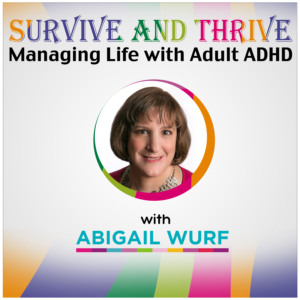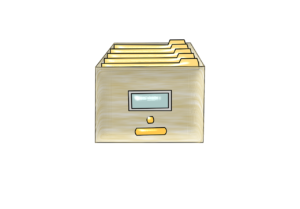 Find past episodes of the show below and be sure to subscribe on iTunes so you never miss an episode.
Find past episodes of the show below and be sure to subscribe on iTunes so you never miss an episode.
Why I am Thankful for My Struggles
 I never thought I would say this but I am thankful for my ADHD and for my chronic pain. Weird huh! Well here is the thing, prior to knowing I had ADHD and prior to surgery resulting in chronic pain, I didn’t think much of myself. All the things that come with ADHD that I struggled with prior to my diagnosis at 30 felt like moral failings. Maybe I could have gotten started sooner, maybe I could have left earlier, maybe I was lazy – my struggles I thought were a reflection on the type of person I was.
They were, but not in the way I thought. I thought that my lack of success and feelings of overwhelm were because I was a weak person. Once I found out about the ADHD and started getting help, my struggles were still a reflection on the type of person I am but the reflection is a positive one.
I was making it. Meaning I was not just surviving but learning how to flourish. This probably seems strange and not to say there weren’t some hard times but I coped and the fact that I coped and kept going means that I am strong, have grit and perseverance. My difficulties forced me to dig deep inside to find the energy to get up each day no matter how my mind or body was feeling. After awhile you start to realize that you are managing despite obvious difficulties. This causes you to lead to the conclusion that you are not a waste of space.
Once I began to perceive that I was stronger than I thought, I became more confident to try new things, do the tough stuff and simply keep moving forward.
What are you struggling with? Are you ignoring your successes and accomplishments because you are struggling in some areas? Success breeds success. Acknowledge when you stick to something, complete something or understand something. Send a message to yourself reminding you what you have accomplished even if it is a little thing. Little things can accumulate and turn into big things.
Don’t think of your struggles as holding you back so much as calling you to engage, be present. If you keep moving forward despite your difficulties by an inch or a mile you are succeeding regardless.
I never thought I would say this but I am thankful for my ADHD and for my chronic pain. Weird huh! Well here is the thing, prior to knowing I had ADHD and prior to surgery resulting in chronic pain, I didn’t think much of myself. All the things that come with ADHD that I struggled with prior to my diagnosis at 30 felt like moral failings. Maybe I could have gotten started sooner, maybe I could have left earlier, maybe I was lazy – my struggles I thought were a reflection on the type of person I was.
They were, but not in the way I thought. I thought that my lack of success and feelings of overwhelm were because I was a weak person. Once I found out about the ADHD and started getting help, my struggles were still a reflection on the type of person I am but the reflection is a positive one.
I was making it. Meaning I was not just surviving but learning how to flourish. This probably seems strange and not to say there weren’t some hard times but I coped and the fact that I coped and kept going means that I am strong, have grit and perseverance. My difficulties forced me to dig deep inside to find the energy to get up each day no matter how my mind or body was feeling. After awhile you start to realize that you are managing despite obvious difficulties. This causes you to lead to the conclusion that you are not a waste of space.
Once I began to perceive that I was stronger than I thought, I became more confident to try new things, do the tough stuff and simply keep moving forward.
What are you struggling with? Are you ignoring your successes and accomplishments because you are struggling in some areas? Success breeds success. Acknowledge when you stick to something, complete something or understand something. Send a message to yourself reminding you what you have accomplished even if it is a little thing. Little things can accumulate and turn into big things.
Don’t think of your struggles as holding you back so much as calling you to engage, be present. If you keep moving forward despite your difficulties by an inch or a mile you are succeeding regardless.The Good with the Bad
 I hate Las Vegas! As a child I would have to come to Las Vegas for conventions my parents had to attend. I found it very depressing because often the hotels had rooms where people could drop off their kids to be watched while they were busy gambling or at a convention.
I hate Las Vegas! As a child I would have to come to Las Vegas for conventions my parents had to attend. I found it very depressing because often the hotels had rooms where people could drop off their kids to be watched while they were busy gambling or at a convention. What made me sad was that sometimes when my parents came to get me around dinner time, other kids were still there who had been there all day. The next morning when I would come back, the same kids were still there and in the same clothes because their parents had left them there overnight. Luckily these areas often had cots for kids whose parents didn’t show up until the next day.
On the bright side, these set aside rooms had tons and tons of crafts you could do. I loved spending all day making things with the employees encouraging me. So while the kids’ drop place could be depressing, it could also be great fun. I remember feeling conflicted because I was having a grand time while some of the kids were wondering why their parents hadn’t come back for them yet.
“In life,” they often say “you take the good with the bad.” I found this hard when I was young. Now as an adult whenever there is a bad situation I try see if I can make the situation better first but even if I can’t I make sure to force myself to try and find some good in the situation. It is almost always possible to do so and it improves the quality of your life and the lives of those around you.
Are You Falling into Any of These Filing Traps?
Are You Falling in Any of These Filing Traps
It was rumored, incorrectly, that the advent of the computer would put an end to paper files. It seems it has only increased the number papers we have around plus now you have to keep track of digital files as well. If you are one those who has gone completely paperless in your office, you can stop reading now.
For the rest of us humans, especially those of us affected by ADHD, filing paper and digital files can be a hassle. Especially if you fall into some of these traps:
Complicated, highly detailed filing system –
The trap here is the system, while it may be elegant, is onerous and therefore you don’t use it. The thinking is you will just file the paper(s) away later when you have time.
Perfectly matching filing system –
The trap here is that if don’t have the right color label or file folder, or however the system is made uniform, you don’t make the file or label putting it off until you have the right matching supplies.
Different systems for your paper and digital files –
The trap here is that the systems are not interchangeable so that you need to remember two systems instead of one. Often this results in inconsistencies because you can’t remember the rules for each set up.
How to stay out of these traps:
 Keep your filing systems simple, the more complex, the less likely you will utilize them.
Keep your filing systems simple, the more complex, the less likely you will utilize them.
Don’t create color-coded or the like systems unless you always keep a bountiful amount of supplies. If you are out of some filing supply, it is just one more deterrent to getting stuff filed.
Try to have your paper and digital files mirror each other as much as possible that way regardless of paper or digital you know immediately where to look for the file and know immediately how to label newly created files.
For example, I group my paper files under the same categories that I tag my digital files for the most part. There are some files that will only exist digitally and some files that will only exist as paper, ever. But for the most part they are similar so I know where to look on my computer and in my paper files to find something. This is especially helpful if I can’t remember whether the file is paper or digital. I only have to check one area of paper files and one area of digital files. Recently I needed to find my coaching certificates that I have earned to send in for my re-certification. Very quickly I could ascertain which I had digitally and which I had hard copies of. Now I know which to scan and which to attach to my re-cert application.
In conclusion –
The simpler the system the better and have your digital and paper systems mirror each other as much as is reasonable and workable. The key is for it to take little time to find something. Also, as I tell all my ADHD affected clients in regards to paper files, if you have to make the choice as to easier to get or easier to put away, make it easier to put away. The logic is that when you need something you are motivated to get it. But once you no longer need it or are done with it, there is not similar motivation to put it away. Happy filing.
How to Know What to Get Rid of When “Editing Yourself”
How to know what to get rid of?
In the past I have written a blog on what my family calls “editing yourself.” This means getting rid of what you don’t need to have. I have done a podcast on this recently https://abigailwurf.com/023-editing-yourself/. The blog post can be found at https://abigailwurf.com/editing-yourself/.
What I want to explore more in depth here is how do you know what to get rid of. This can be hard for anyone but especially those of us affected by ADHD.
There are good reasons to get rid of stuff.
- There is a sense of accomplishment
- Your place usually looks better
- You know where to find what you want immediately
- Duplicates of items have been eliminated
- You, if you give away the stuff, offer the opportunity for someone else, most likely less fortunate, to enjoy what you are not using.
What to get rid of? This can be hard because many of us struggle with getting rid of anything. I think the most common concern is “what if I need it in the future?”
Luckily, there are places such as “Amazon” where if need be you can replace it if it ever comes to that. Usually, the majority of stuff we get rid off we never notice. This is because most of what we get rid of are things that we no longer use often or at all and things that no longer function properly.
A well known, and good way to decide, if you need to keep something you are not sure about is to box it up. Put it in a box or if it is big, in a closet. Put two dates on it. The date you packed it up and six months from that date.
Put the six months date in your calendar. On that date if you haven’t opened the box or gotten the large object out, it is given away or tossed depending what it is. If the box has not been opened in the last six months then that doesn’t mean you open it and re-evaluate, you just get rid of it. You can do a shorter time than six months, it is up to you what works for you. There are also some things which don’t need the wait time. You know immediately that it no longer is a necessary part of your life. Get rid of those things immediately.
Of course this is not how you should handle certain, valuable heirlooms. When I say “valuable” I don’t necessarily mean monetary value. Things can have historic or cultural value. That doesn’t mean you necessarily keep it but maybe find a good home for it.
For example, when I was growing up our basement held a lot of memorabilia. There were posters that I saw in my history books in our basement. When we decided to move a gentleman came out from a university and took most of the memorabilia for their archives where it still exists today. And probably in much better shape than if we had kept it. Also, the collection is available for others to study and examine.
Not everyone is going to have stuff that has cultural or monetary value but you never know. When it comes to valuables, think about if you are really going to use or treasure the valuable. For example I have some jewelry that I treasure, not sure if it is valuable but I make a conscious effort to wear the jewelry and not just let it sit in a box. Enjoy yourself, share your stuff or get rid of it so that others can benefit from it.
This is hard to do. I know I struggle with getting rid of stuff. The constant question is “what if I need it in the future?” The answer is – is it replaceable, borrowable, rentable, etc.? If it is then you have options if in the rare instance you need it again. Be real with yourself. Ask yourself “what is the likelihood that I will ever use this again?”
Like I said, this is hard. I continue to struggle all the time with this. But I have found one thing out. Once you begin to get rid of stuff it gets easier as you see virtually no negative ramifications from getting rid of whatever you let go of. Also, it is enjoyable to see that space you just cleared out looking good.
We cleared out my second bedroom. It took days. I wanted it cleared out but I also didn’t want to give up any of the stuff. What if I might need it in the future? But, once I got started it became easier to give stuff away. What helped was I found a place to take my arts and crafts supplies that I wasn’t using. It was a church that was having a bazaar to raise money. I am not a member of that church but they do good works so that made it easier for me to give away stuff because I knew it would benefit others.
So having an incentive can help. Also the more we cleared things out of the bedroom, the more pleasant the room became which made me happy.
It is best to have a plan where the stuff is going to go before you start sorting it out. After I cleared the bedroom, I got excited and started sorting all the piles of books around my condo and in my bookshelves without a plan as to where the books would go.
Remember that cleared out second bedroom I mentioned? Well it is no longer cleared out because I have over 10 boxes of books in there waiting for a new home. I have now found a place to take them and hope to do that this weekend. Mind you I boxed the books up about a year ago! We are all works in progress at least that is what I keep saying to myself.
Get rid of what you can. Box up and date what you can’t decide about. Put in your calendar when you will get rid of it if you don’t open the box in advance. Have a place as to where the box will go so when time is up it goes there and doesn’t continue to take up unnecessary space in your home or office.
Good luck!
Trying To Start a New Habit? Six Steps to Success
Trying to Start a New Habit?
Almost everyone I know or have worked with, have some habit they want to develop or behavior they wish to change. Unfortunately, it is not easy to develop a new habit or change a behavior especially if you are affected by ADHD.
 But it is possible and will cause discomfort. The thing to remember is that it is not an all or nothing game. There are varying stages of success and you need to appreciate all of them.
But it is possible and will cause discomfort. The thing to remember is that it is not an all or nothing game. There are varying stages of success and you need to appreciate all of them.
First the habit or behavior is bright, “shiney” and new. It is a novelty so you make it happen, if you remember. Then after awhile you either start forgetting or are no longer motivated to act in the new way.
The second stage is the forgetting or loss of motivation. You are at a decision point. You either decide you have messed up and quit or you acknowledge the misstep but not use it as an excuse to quit.
The third stage, the starting again, is hard because the novelty that pushed you forward before no longer exists or at a much reduced level. This is getting back on the horse after you have fallen. It is tough because you know it will most likely happen again in the not to distant future.
The fourth stage is a repeat of the second stage of stopping, forgetting or wanting to quit.
The fifth stage is starting yet again the behavior or habit you are trying to change or adapt. The key is to look at the number of days you were successful and not the days you were not successful except to examine them is a curious manner. Try to remember what got in your way of your goal to change. What happened in the instant you decided not to do the new behavior or habit? How can you re-address the situation if it occurs again?
The first five stages can loop over and over again for awhile and it is important to remember that change is extremely uncomfortable and hard.
The sixth stage and final stage is when you are automatically achieving your habit or behavior change without thought. But you will have to loop through the stages, most likely more that once to get here. Once here you must still remain vigilant and not to slip back into stage two or four. You will most likely but then you just start again.
Final thought: When starting a new habit, research has shown the best way to do this is to hook the new habit to a habit you already have. For example, hopefully you are in the habit of brushing your teeth every morning! Now the new habit you want to start is to begin taking vitamins every morning. Hook the two activities together. Do the new habit right after you do the old established habit.
Don’t Resist Goal Setting, Recalibrate
 Many people are resistant to goal setting. But if you are affected by ADHD you are more likely to be resistant to setting goals. I have no scientific data to support this opinion. All I can say is 100% of my clients, past and present, struggle with goal setting. Nonetheless, I believe goal setting is important. And if you don’t like the idea of setting goals, think in terms of setting intentions.
Many people are resistant to goal setting. But if you are affected by ADHD you are more likely to be resistant to setting goals. I have no scientific data to support this opinion. All I can say is 100% of my clients, past and present, struggle with goal setting. Nonetheless, I believe goal setting is important. And if you don’t like the idea of setting goals, think in terms of setting intentions.
Goal setting helps you to:
- Achieve milestones or goals that you desire over a period of time.
- Have a clear direction as to what to do next to get where you want to go.
- Have focus.
- Move your life forward.
- Have clarity on what you want.
Unfortunately, those of us affected by ADHD struggle with the concept of and/or act of setting goals. I think this is because we don’t believe we can achieve our goals. Often our personal history gets in our way because we are more acutely aware of goals we didn’t achieve as opposed to goals we did achieve. The overhanging senses of failure and frustration that commonly dog people affected by ADHD are hard to overcome.
Partly, I believe, it’s because we often take things too literally. As the saying goes, “The only constant is change.” The act of writing down and committing to a goal is important but it is equally important that as time moves forward, one’s goal has to move forward as well. This means making adjustments as needed by being responsive to whatever factors affect the initial goal. The problem is that we see adjustments or re-calibrations to a goal as failure when in truth it is responsiveness and “attentional.”
What you know when you first set a goal is not the same as what you know weeks or months into working toward the goal. The more informed you are by your experience, the more likely your goals will change as you progress forward with your life. Stop seeing that as failure. Write down your goals and if need be do it in pencil so you can easily adjust as you go along. Sometimes after setting a goal we realize that it was not realistic for us. That is OK. Live and learn. The only one who needs to know if you have abandoned a goal is you, and that is not failure. It simply means the goal you set out to achieve is not going to happen, at least in the short term. Move on.
When I wrote my book, “Forget Perfect: How to Succeed in Your Profession and Personal Life Even if You Have ADHD” I thought it would take me about four months. In reality it took me almost a year. My goal was set on the foundations of ignorance. I simply had no idea what it took to write a book. That is not failure. Let go of perceiving unrealistic timelines as failure. What was important is that I got the book done and am satisfied with the result. Could I have done it quicker? Probably. Could it be better? Probably. None of that matters if I am satisfied with my outcome, the book got done, and is in the ballpark as to what I imagined it would be. Success!
